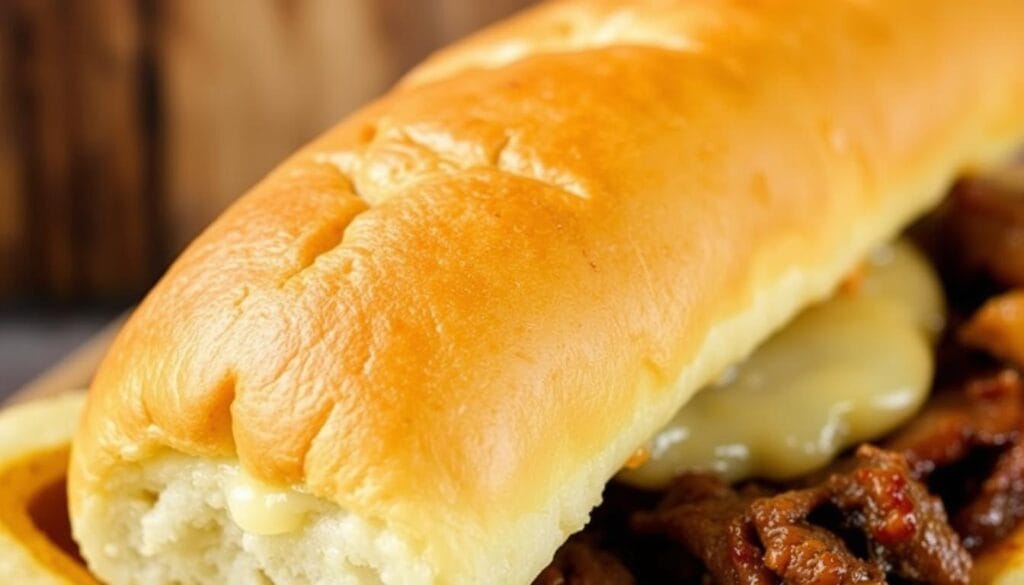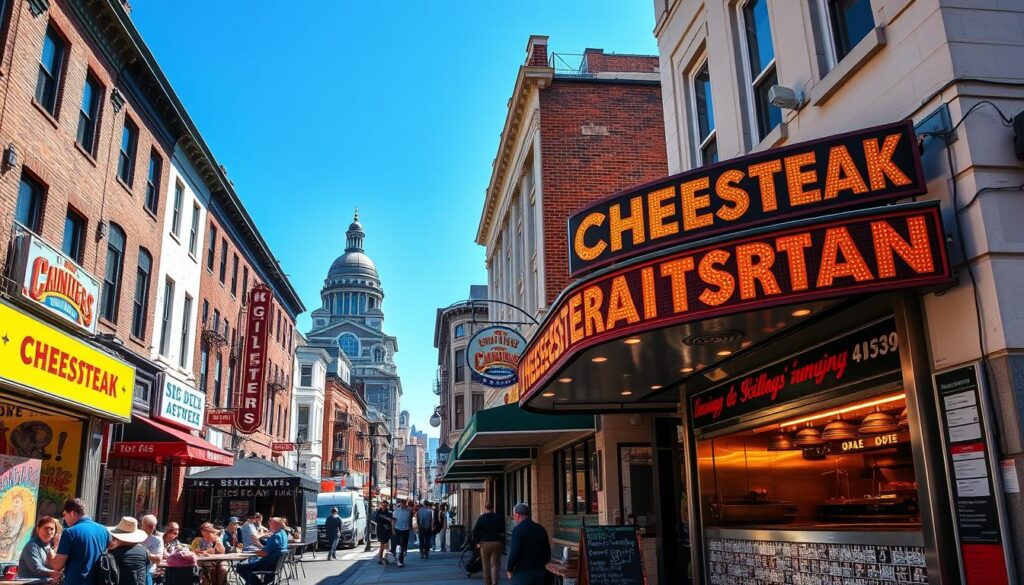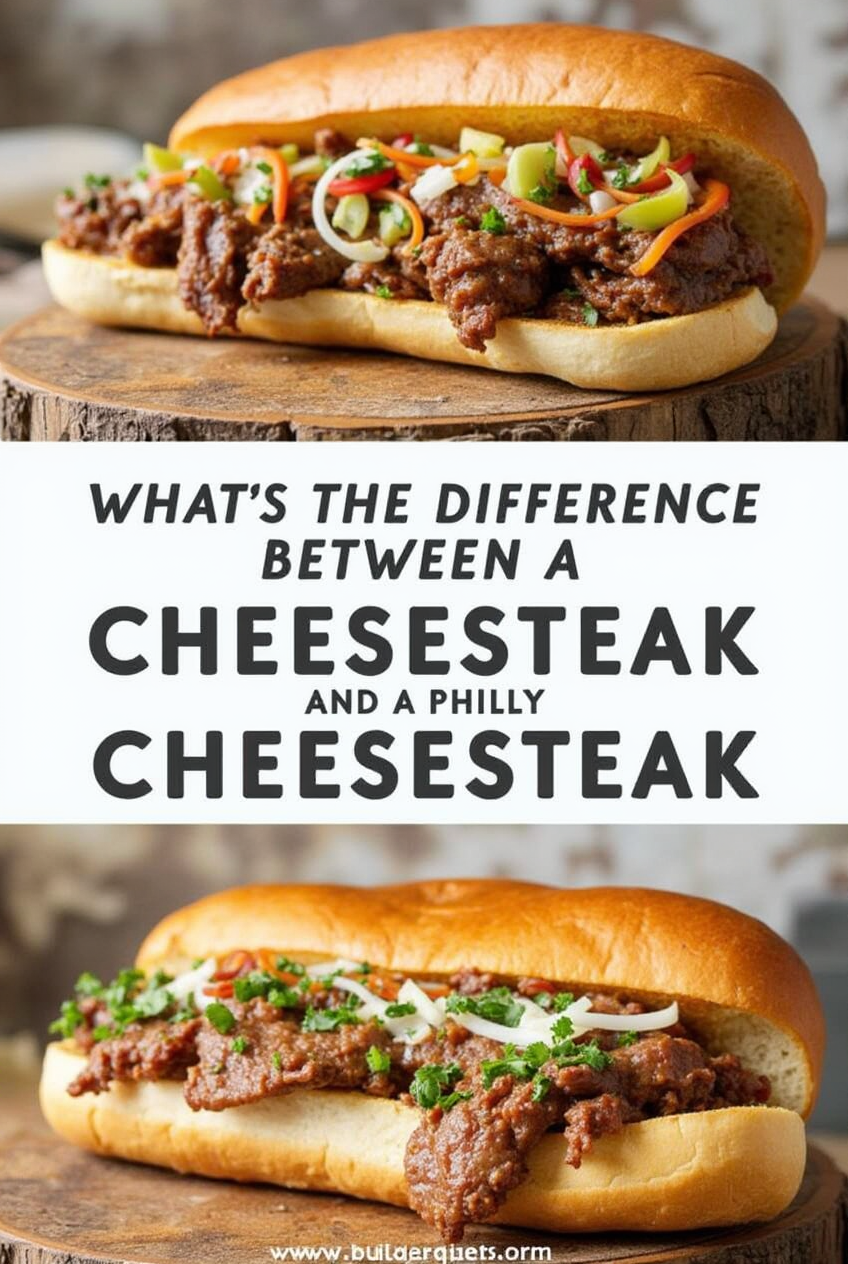what’s the difference between a cheesesteak and a philly cheesesteak? It’s more than just meat and cheese. Philadelphia’s food scene is rich and diverse.
In 1930, Pat Olivieri started selling hot dogs in Philly. He accidentally made a sandwich that changed the city’s food forever.
A Philly cheesesteak is more than its ingredients. It’s a symbol of Philly’s food culture. From its start to becoming a national hit, it’s a story of creativity and tradition.
Table of Contents
The History and Origins of the Philadelphia Cheesesteak
The story of the Philadelphia cheesesteak is a tale of culinary innovation. It began as a simple idea in Philadelphia. This idea would grow into a beloved dish that touches the hearts of many.
In 1930, Pat Olivieri, a hot dog vendor in South Philadelphia, created a sandwich that would change the city’s culinary landscape forever. While working at his modest stand, he improvised a meal using meat scraps and a hoagie roll, unknowingly birthing an iconic dish.
The Original Creation
Legend has it that Olivieri first made the sandwich for a hungry taxi driver. The cab driver was so impressed that word quickly spread about this new delicacy. Key milestones in the cheesesteak’s history include:
- 1930: Pat Olivieri invents the original steak sandwich
- 1939: Jim’s Steaks begins operation
- 1940s: Cheese is introduced to the sandwich
Evolution of a Cultural Icon
The sandwich quickly became more than just a street vendor’s creation. Olivieri soon opened Pat’s King of Steaks at 9th Street and Passyunk Avenue. This place became a key part of Philadelphia’s food scene.
“A simple sandwich that would define a city’s cuisine” – Philadelphia Food Historians
| Year | Milestone |
|---|---|
| 1930 | First steak sandwich created |
| 1940s | Cheese added to the sandwich |
| 1970s | National recognition begins |
By the 1970s, the cheesesteak was more than a sandwich. It was a symbol of Philadelphia’s spirit and its working-class roots.
Authentic Philly Cheesesteak Components
Making an authentic Philly cheesesteak starts with the right ingredients. The base is premium thinly sliced ribeye steak. It’s known for its great marbling and tender texture.
The key parts of a traditional Philly cheesesteak are:
- Thinly sliced ribeye steak
- Melted cheese (Cheez Whiz, provolone, or American)
- Fresh hoagie roll
- Optional caramelized onions
Ordering a Philly cheesesteak often involves saying “wit or witout.” This decides if you want onions. People take this choice very seriously, as it changes the sandwich’s taste.
“A true Philly cheesesteak is an art form, not just a sandwich” – Philadelphia Food Critic
The hoagie roll is key to the sandwich’s success. Philly bakeries make soft, crusty rolls that match the meat and cheese. Your cheese choice can also change your cheesesteak experience. Cheez Whiz gives a classic taste, while provolone adds a sophisticated flavor.
Creating the perfect cheesesteak needs focus on detail. It’s about choosing top-notch ingredients and mastering cooking techniques. These steps turn simple parts into a culinary masterpiece.
What’s the Difference Between a Cheesesteak and a Philly Cheesesteak
Exploring the sandwich rivalry between cheesesteaks is key. The Philly cheesesteak is unique. It’s more than just a sandwich; it’s a culinary icon.
Geographic Authentication
A true Philly cheesesteak has a special touch. You can find cheesesteaks everywhere, but a real Philly one comes from Philadelphia’s streets. The city’s culture makes these sandwiches stand out.
Ingredient Standards
Philly cheesesteaks have specific ingredients:
- Rib-eye steak, sliced very thin
- Specific cheese options: Cheez Whiz, provolone, or white American cheese
- Authentic hoagie rolls that are 1-inch thick
Preparation Methods
How it’s made makes a Philly cheesesteak special. Vendors like Pat’s and Geno’s use unique methods:
- Freezing ribeye for 20-30 minutes to get the right thinness
- Chopping or slicing meat on a flat-top grill
- Caramelizing onions for 15-20 minutes to add sweetness
“A Philly cheesesteak is not just a sandwich, it’s a culinary tradition.”
Knowing the difference between a cheesesteak and a Philly cheesesteak shows a deep food heritage. It’s more than just ingredients and how it’s made.
The Art of Choosing the Right Roll

The hoagie roll is key to a great Philly cheesesteak. It’s not just any bread that will do. The right roll can turn a simple sandwich into a work of art.
Amoroso rolls are the top choice for authentic cheesesteaks. They have a special quality that makes them stand out:
- Slightly crusty exterior
- Soft, pillowy interior
- Perfect structural integrity
- Ability to absorb meat juices without falling apart
“A great cheesesteak begins with an exceptional roll” – Philadelphia Culinary Tradition
Your hoagie roll should have certain qualities. It should be soft but also hold its shape well. This way, each bite stays together without getting soggy.
| Roll Characteristic | Ideal Quality |
|---|---|
| Texture | Soft inside, slightly crisp outside |
| Length | 6-8 inches |
| Bread Density | Medium-light |
| Moisture Absorption | Moderate |
Pro tip: Lightly toasting your hoagie roll can enhance its texture and prevent sogginess, creating the perfect foundation for your Philadelphia cuisine masterpiece.
The Great Cheese Debate: Provolone vs. Cheez Whiz
The choice of cheese for cheesesteaks is a big deal in Philadelphia. People get really passionate about it. It’s not just about the taste; it’s about tradition and culture.
Traditional Cheese Foundations
Provolone cheese was the first choice for cheesesteaks. It’s made from cow’s milk and has a mild taste. Frank Olivieri, the creator, chose provolone for its authentic flavor.
The Cheez Whiz Revolution
In 1952, Cheez Whiz changed the game. It became a hit, with sales soaring at some places. People loved its creamy texture and taste.
- Geno’s uses 8-10 cases of Cheez Whiz daily
- Pat’s reports overwhelming preference for Cheez Whiz
- Cooper Sharp cheese is gaining popularity in 2023
Regional Cheese Preferences
Your choice of cheese says a lot about you. Some like the classic provolone, while others go for Cheez Whiz. This shows how diverse Philadelphia’s food scene is.
“The cheese makes the cheesesteak” – Philadelphia Food Tradition
Whether you choose provolone or Cheez Whiz, each adds something special to the cheesesteak. It’s all about personal taste.
Proper Meat Selection and Preparation Techniques
Choosing the right meat is key to making a real Philadelphia cheesesteak. New York strip and ribeye are the top picks. They have lots of marbling, making the meat tender and flavorful.
The secret to a great cheesesteak is how you prepare the meat. It’s best to slice the beef very thin, about ¼-inch. Pro tip: Freeze the meat for 1-2 hours before slicing to achieve those paper-thin cuts with ease.
- Preferred beef cuts: Ribeye, New York strip
- Alternative options: Skirt steak, flat iron
- Ideal meat thickness: Approximately ¼-inch
“The magic of a great cheesesteak is in the meat’s preparation and quality,” says a Philadelphia culinary expert.
How you cook the meat is just as important as what meat you use. Cheesesteak experts use flat-top grills and a special chopping method. They chop the meat while it cooks, giving it a unique texture.
Seasoning is also crucial. A mix of salt, pepper, garlic powder, and Worcestershire sauce can make your steak amazing. The goal is to bring out the meat’s natural taste without overpowering it.
| Meat Cut | Price Range | Flavor Profile |
|---|---|---|
| Ribeye | Higher | Rich, Marbled |
| Skirt Steak | Moderate | Intense, Beefy |
| Flat Iron | Lower | Tender, Lean |
Making the perfect cheesesteak is an art. It’s about using quality ingredients, precise preparation, and a love for Philadelphia’s food tradition.
The Role of Toppings and Add-ons
Cheesesteaks are more than just meat and cheese. They’re a canvas for creativity. The right toppings can turn a good sandwich into a memorable meal. Whether you like your cheesesteak wit or witout onions, there’s something for everyone.
Classic Additions
Traditional cheesesteak ingredients have proven their worth. Fried onions are the most iconic topping, with 50% of people adding them for extra flavor. Some classic choices include:
- Caramelized onions
- Sautéed bell peppers
- Mushrooms
Contemporary Variations
Modern cheesesteak fans are trying new things. Sales of alternative sauces have jumped by 25%. Popular new additions are:
- Garlic mayo
- Horseradish sauce
- Fresh lettuce
- Sliced tomatoes
Regional Influences
Different places have their own cheesesteak styles. While some say too many toppings aren’t true Philly cheesesteaks, new versions keep coming. The debate over onions is a fun topic for cheesesteak lovers.
“A great cheesesteak is about balance – too many toppings can overwhelm the core ingredients.” – Philadelphia Cheesesteak Expert
It’s all about finding the right balance. Whether you stick to the classics or try new things, there’s a cheesesteak out there for you.
Famous Philadelphia Cheesesteak Establishments
Exploring Philadelphia’s cuisine reveals a world of legendary cheesesteak spots. These places have shaped the city’s food scene. The rivalry between Pat’s King of Steaks and Geno’s Steaks is a key part of Philly’s food history. They sit right across from each other on East Passyunk Avenue.

- Pat’s King of Steaks (est. 1930)
- Geno’s Steaks
- Jim’s Steaks
- Tony Luke’s
- John’s Roast Pork
Each place adds its own twist to the classic cheesesteak. Pat’s King of Steaks, started by Pat Olivieri in 1930, is said to have created the first cheesesteak. It’s open 24/7, so you can get your cheesesteak fix anytime.
“A cheesesteak isn’t just a sandwich in Philadelphia—it’s a culinary tradition.” – Local Food Critic
When you order at these famous spots, you need to know the local speak. People say “whiz wit” to ask for a cheesesteak with Cheese Whiz and onions. Most places offer three cheese choices: Cheese Whiz, white American, and provolone.
While Pat’s and Geno’s get all the attention, places like Sonny’s Famous Steaks offer something special. Whether you’re new to Philly or a local, these cheesesteak spots are the heart of Philly’s food culture.
Common Misconceptions About Cheesesteaks
Many people get confused about the difference between cheesesteaks and Philly cheesesteaks. Knowing the real difference can help you avoid making mistakes when ordering.
- Not every steak and cheese sandwich is a Philly cheesesteak
- Green peppers are not a traditional topping in an authentic Philly cheesesteak
- Cheese choices matter more than you might think
“A true Philly cheesesteak is more than just meat and cheese on a roll – it’s a culinary tradition.”
Some folks think any steak sandwich with cheese is a Philly cheesesteak. But, where it’s from and how it’s made are key to being authentic.
| Misconception | Reality |
|---|---|
| Any steak sandwich is a Philly cheesesteak | Only sandwiches from Philadelphia with specific ingredients qualify |
| Green peppers are traditional | Authentic recipes typically do not include green peppers |
| Any cheese works | Cheez Whiz and provolone are the most traditional choices |
Knowing these details helps you enjoy a real Philly cheesesteak. It also makes you a better sandwich connoisseur.
Conclusion
Your journey into Philadelphia’s cuisine shows the cheesesteak as more than food—it’s a symbol. It’s a meal that goes beyond ingredients, showing a deep tradition in urban culture and local pride.
Knowing the difference between a generic sandwich and a Philly cheesesteak is key. It’s about understanding its history. From Pat and Harry Olivieri’s first cart to today’s gourmet versions, it stays true to its simple yet flavorful roots.
In Philadelphia, a real cheesesteak is a work of art. It’s about the perfect mix of beef, cheese, and roll. Each bite is a taste of tradition, innovation, and pride.
Whether you love food or just enjoy eating, trying a Philly cheesesteak is special. It connects you to a rich culinary history that inspires food lovers everywhere.

